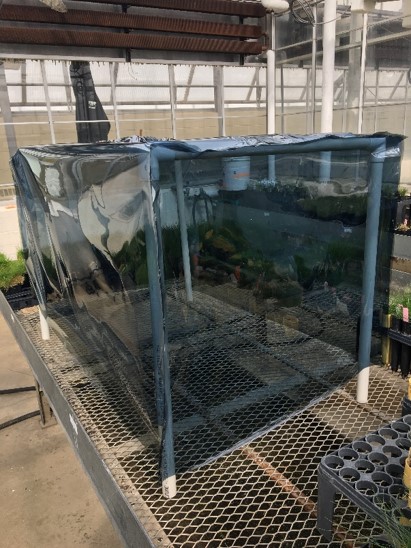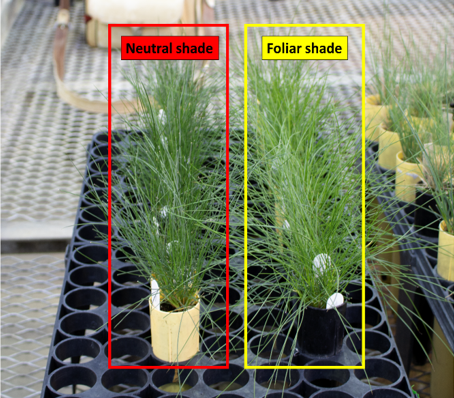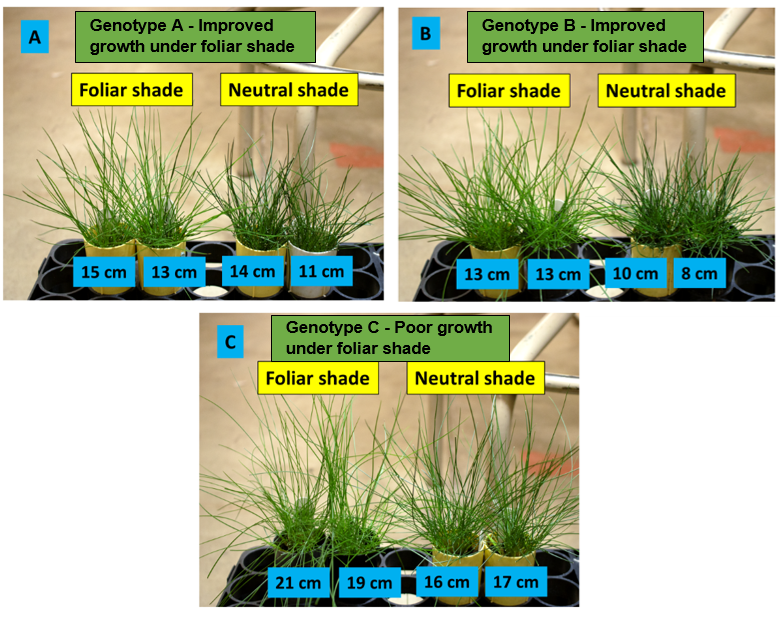By Dominic Petrella
It is a common misconception that turfgrasses respond the same to neutral and foliar shade conditions. However, this is not true, and even some of the best turfgrasses for shady areas exhibit contrasting growth under these different types of shade. Let’s define the two types of shade:
- Neutral shade (also termed quantitative shade) is produced from building structures and/or objects that cast shadows or block light from reaching the turf. Neutral shade only involves reductions in the amount of light; reductions in light quantity only.
- Foliar shade (also termed qualitative shade) is produced from overhead/neighboring foliage that 1) decreases the amount of light that reaches the turf and 2) filters the light that the turfgrass will absorb. Together, this changes the quality of the light, and specifically changes the ratio of red to far-red light (R/FR ratio).
In our greenhouse, we are currently screening for hard fescue turfgrasses (along with other fine fescue species) that exhibit improved growth under foliar shade using sheets of plastic that filter light in a way that is similar to leaves (Figure 1). From this work, we selected individual hard fescue genotypes that showed improved growth and genotypes that displayed poor growth. As a side experiment, we took a handful of these plants and grew them under either neutral shade or foliar shade in growth chambers (spaces with tightly controlled environmental conditions) to see how these plants responded to these different types of shade.
We chose four hard fescue genotypes that grew well under our greenhouse selection, and two genotypes that did not grow as well. We then vegetatively propagated these genotypes (creating clonal replicates) so we could directly compare how plants with identical genetics grew under neutral or foliar shade.
For our neutral shade treatment, plants were grown in a growth chamber with a 16 hr daylength, day temperature of 25˚C, night temperature of 20˚C, 100 µmol m-2 s-1 light intensity, and a R/FR ratio of approximately 5.0 using fluorescent lights only. For our foliar shade treatment, plants were grown in a growth chamber with a 16 hr daylength, day temperature of 25˚C, night temperature of 20˚C, 100 µmol m-2 s-1 light intensity, and a R/FR ratio of approximately 0.14 produced by including far-red LED lights.
A R/FR ratio of 0.14 is similar to what can be observed under heavily shaded areas, while a R/FR ratio of 5.0 is typical of fluorescent lighting and simulates R/FR ratios above 1.0 (full sun R/FR ratios average between 1.1 – 1.2).
After 2 weeks of growing under these conditions we could easily see the differences in growth produced from neutral and foliar shade (Figure 2 and 3). The first obvious difference was that plants grown under foliar shade had leaves that were much lighter green in color (Figure 2). The only environmental difference these plants were exposed to was the R/FR ratio, showing that a reduced R/FR ratio can have profound effects compared to reductions in light quantity only. Prior to this experiment, we also trimmed all the plants to 3 cm in order to evaluate leaf elongation.
We saw differences in leaf growth (Figure 3). After 2 weeks of growth, genotypes that were selected for improved growth under foliar shade were 14.3 cm tall, on average, when grown in our foliar shade growth chamber, and these same genotypes were 12.5 cm tall, on average, under neutral shade. The genotypes selected for poor growth were 20 cm tall under foliar shade, and 18.3 cm under neutral shade. While this shows that foliar shade produces different responses compared to neutral shade overall, we also saw interesting variation (Figure 3).
As you can see in Figure 3, genotype “A” grew very similarly under both foliar and neutral shade, while genotype “B” displayed a much more compact growth habit under neutral shade compared to the other genotypes. Both genotypes “A” and “B” were selected for improved growth under foliar shade in our greenhouse experiments, but they grew differently under neutral shade. If we were to only screen under neutral shade on the other hand, we would assume that genotype “B” would grow better under shade compared to genotype “A”; however, our results show that under foliar shade these two genotypes are very similar. We can hypothesize that genotype “A” isn’t as sensitive to foliar shade due to showing less of a response to the reduced R/FR ratio, while genotype “B” is more sensitive to this change due to showing a rather large increase in growth compared to its counterparts grown under neutral shade.
While turfgrasses are sometimes grown in areas with neutral shade only (sports stadiums, areas that only receive casted shadows of trees, houses that lack trees/shrubs, etc.), the majority of shade experienced by turfgrasses can be classified as foliar shade. These experiments are ongoing, but our initial results show is that fine fescues respond differently to neutral and foliar shade even though these grasses are considered some of the best turfgrasses for shady areas. Because of this, it is important to include foliar shade in experiments evaluating turfgrass growth under shade. If only neutral shade is evaluated, the entire story cannot be told.
Dr. Florence Sessoms is currently using these methods to help improve hard fescue seed production. In northern Minnesota (Roseau), hard fescue could be intercropped with wheat for seed production. Unfortunately, the fast growth habit of wheat results in intense foliar shade for the fescue. As a result, the hard fescue does not establish very well under spring planted wheat. Moreover, recent observations have shown that number of flowering culms produced by the hard fescue the following year after wheat harvest is reduced. Dr. Sessoms is using the shade screening methods described to screen a panel of hard fescue accessions for establishment and flower production under foliar shade.
Acknowledgements
The shade fine fescue research being done by Dr. Dominic Petrella is being supported under a grant, "Increasing Low-Input Turfgrass Adoption Through Breeding, Innovation, and Public Education", from the USDA-NIFA through the Specialty Crop Research Initiative. The hard fescue research being done by Dr. Florence Sessoms is being supported under a grant, "Novel Cropping Systems for Economic and Environmental Improvement in Hard Fescue Seed Production", from the Minnesota Department of Agriculture.


